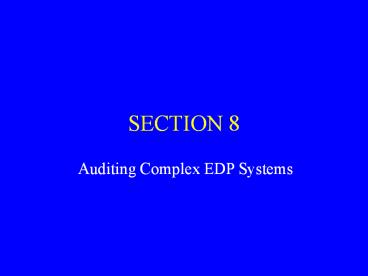Auditing Complex EDP Systems - PowerPoint PPT Presentation
Title:
Auditing Complex EDP Systems
Description:
... ensure completeness and accuracy of input concerned with data manipulation once it is in the computer what type of control can used as a process control? – PowerPoint PPT presentation
Number of Views:261
Avg rating:3.0/5.0
Title: Auditing Complex EDP Systems
1
SECTION 8
- Auditing Complex EDP Systems
2
Auditing Complex EDP Systems
- Computer used extensively
- simple batch processing
- complex on-line, real-time processing
- Computer affect two aspects if audit risk
- assessing control risk
- managing detection risk
3
Around vs. Through the Computer
- Around
- manually calculate INPUT and trace to OUTPUT
- Through
- test the controls in the computer
4
Impact of Computer Controls
- Change in the Audit Trail
- less documentation offset by programmed controls
- file storage reduces need for hard copy
- testing shift to examination of EDP controls
5
- Combination of Functions
- computer processing allows combining functions
that are usually separate in manual systems - e.g. input editing of a sales transaction
- customer number
- credit limit
- inventory number and price
6
Types of EDP Accounting Systems
- Batch Processing
- accumulated and processed in groups
- what is the main form of control?
- the main problem?
7
- Batch Processing System
8
- Real-Time Processing
- transactions are edited on-line as they occur
- continuous file updating
- more complex than batch
- how does this method affect the audit trail?
9
- Batch Processing System
10
Time Sharing and Service Bureaus
- Time sharing
- an entity processes data for itself and other
entities - i.e. shares its computer
- Service bureau
- process transactions for other entities
- i.e. this is their business
11
Separate Files vs. Integrated Data Base
- File System
- main characteristic?
- Data Base
- main characteristic?
12
Hardware Configurations
- Electronic Data Interchange (EDI)
- on-line format
- computer-to-computer exchange
- public standard format
- Accredited Standards Committee of the American
National Standards Institute - ANSI X12
13
- Two methods for EDI
- The Direct Approach
- The Indirect Approach
14
- Small Computer Systems
- small firms
- low cost and advanced hardware
- Distributed Data Processing
- companies with branches and divisions
- geographic dispersion
15
- A Distributed System
- Types of computers at the branches?
16
Kinds of EDP Controls
- Two main classifications
- General controls
- Application controls
17
- General Controls
- Organization and Operating Controls
- segregation of duties very important
18
- Systems Development Documentation
- control over definition, design, development,
testing, and documentation of systems - once designed and developed, the system must be
thoroughly tested - systems and programs must be documented
- 1.
- 2.
- 3.
19
- Access Controls
- prevents unauthorized use
- batch systems
- who controls access in this case?
- on-line systems
- primary control for access?
20
- Data and Procedural Controls
- to control daily operations
- backup files on and off the premises
- environmental controls
21
- Application Controls
- a separate set for each application controls
- How are application controls classified?
- Input Controls
- computer edit controls
- ensure completeness and accuracy of input
22
- Process Controls
- concerned with data manipulation once it is in
the computer - what type of control can used as a process
control? - Output Controls
- verification and distribution of output
23
Techniques for Testing EDP-Based Controls
- Best to understand as a number of steps as shown
in the following flowchart
Test further
24
- Gaining an Understanding of EDP Controls
- Two main ways
- observation and enquiry
- studying the system and program documentation
- Observation and Enquiry
- should look for the following
- Segregation of functions
- Control of access to files and programs
25
- Approval of new systems and programs
- Existence of hardware and environmental controls
- The functioning of data and procedural controls
- Backup files
26
- Systems and Program Documentation
- Documentation is an integral part
- Should include
- 1.
- 2.
27
- The Testing of EDP Controls
- Auditor should be able to identify those controls
that are necessary for the effectiveness of the
application - by testing these controls, which component of
audit risk may be reduced? - Two ways to look at testing
- 1.
- 2.
28
- Auditing Around the Computer
29
- Auditing Through the Computer
30
Techniques for Auditing Through the Computer
- Test Data Approach
- simulated data
- of what should this data consist?
- main problems of this approach
- 1.
- 2.
31
- Mini Company Approach
- also called the Integrated Test Facility
- a fictitious entity is created
- fictitious transactions are processed along with
regular transactions - any problems with this approach?
32
- Simulation / Auditors Program Approach
- Auditor creates an application program that
simulates the system - uses client data as input
- potential uses of this approach
- sampling
- computations
- comparing
- summarizing
33
- Generalized Audit Software
- most common type of audit software
- transportable from one client to another
- independent
- limited by the availability of the clients data
files
34
Small Computer Systems
- Widespread
- Weaknesses in General Controls
- 1. Lack of segregation of duties
- 2. Location of the computer
35
- Limited Knowledge of EDP
- Special Consideration for Application Controls
- 1. Data Entry
- 2. Data processing
- 3. Absence of Limit and Reasonableness Tests
36
- Study and Evaluation of Internal Control
- The effect of computer size on the auditor
- General controls are often weak
- More reliance on application controls
- If application controls and any manual controls
are not reliable, what should the auditor do with
regards to testing?































